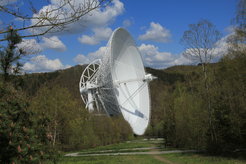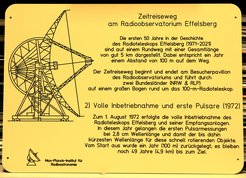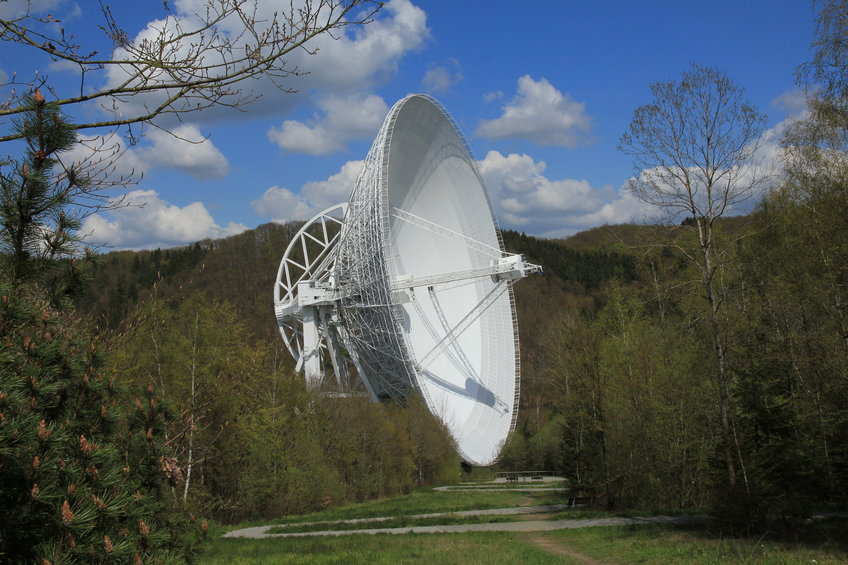Full commissioning of the Effelsberg radio telescope
Regular observations with the 100-m telescope started 50 years ago, on August 01, 1972
The 100-m radio telescope of the Max Planck Institute for Radio Astronomy in Bonn celebrated its 50th birthday in 2021. To build the telescope in a valley in the Eifel hills about 40 km southwest of Bonn required a three and a half year construction period from 1967 to 1971, which was completed with the official inauguration on May 12, 1971. It would then take a little more than a year before the telescope was fully commissioned on August 01, 1972, with the start of the regular observing program.

The 100-m radio telescope of the Max Planck Institute for Radio Astronomy (MPIfR) is located in a valley directly on the border between the German states of North Rhine-Westphalia and Rhineland-Palatinate. From the visitor parking lot near the Eifel villages of Effelsberg and Lethert, both part of the local municipality of Bad Münstereifel, it is about a 15-minute walk to the radio telescope's visitor pavilion with a direct view of the telescope itself.
As a retrospective of 50 years of successful research work with the Effelsberg 100-m radio telescope, a fourth astronomical hiking trail, the "Time Travel Trail," was opened in May 2021 in the neighborhood of the Effelsberg radio telescope. It starts at the visitors’ pavilion in the immediate vicinity of the 100-m radio telescope, leads around the telescope on a route of just over 5 km, and ends at the lookout point directly in front of the giant antenna. From there, a short zigzag path leads directly back to the pavilion.
While the first station panel of the Time Travel Trail is dedicated to the completion of the radio telescope in 1971 (inauguration ceremony on May 12, 1971), the full commissioning and the start of the regular observing program took place in the following year on August 01, 1972.
Panel 2 of the Time Travel Trail (Fig. 2) represents the events in 1972. In addition to the full commissioning, the first pulsar measurements were made with the 100-m radio telescope at a wavelength of 2.8 cm. At this wavelength (corresponding to a frequency of 10.7 GHz), these were the highest frequency measurements of pulsars so far. Pulsars are rapidly rotating neutron stars, discovered only five years earlier in 1967 by Jocelyn Bell-Burnell and Antony Hewish.
"The publication on pulsars by Richard Wielebinski, Wolfgang Sieber, and their co-authors in the journal Nature in 1972 was the first research paper based on observational data obtained with the Effelsberg 100-m radio telescope," says Prof. Michael Kramer, Director at the Max Planck Institute for Radio Astronomy and head of its "Radio Astronomical Fundamental Physics" research department.
The Time Travel Trail describes a series of milestones from five decades of the 100-m radio telescope's history on a total of 20 stations, from its official opening in 1971 to its 50th anniversary in the year 2021.
These include both scientific and technical milestones, from the first discovery of the molecules water and ammonia in external galaxies in 1977/79 to a world record in angular resolution of only 11 microarcseconds (equivalent to the diameter of a 1-cent coin on the surface of the Moon) by Space VLBI observations including the 100-m telescope. In addition, there are technical milestones such as the installation of a new subreflector with active surface elements in 2006 and the commissioning of a second radio telescope on site, the Effelsberg station of the European LOFAR telescope network.
The Time Travel Trail runs for a little more than 5 km around the site of the radio observatory, covering the area of two German states, North Rhine-Westphalia and Rhineland-Palatinate.


